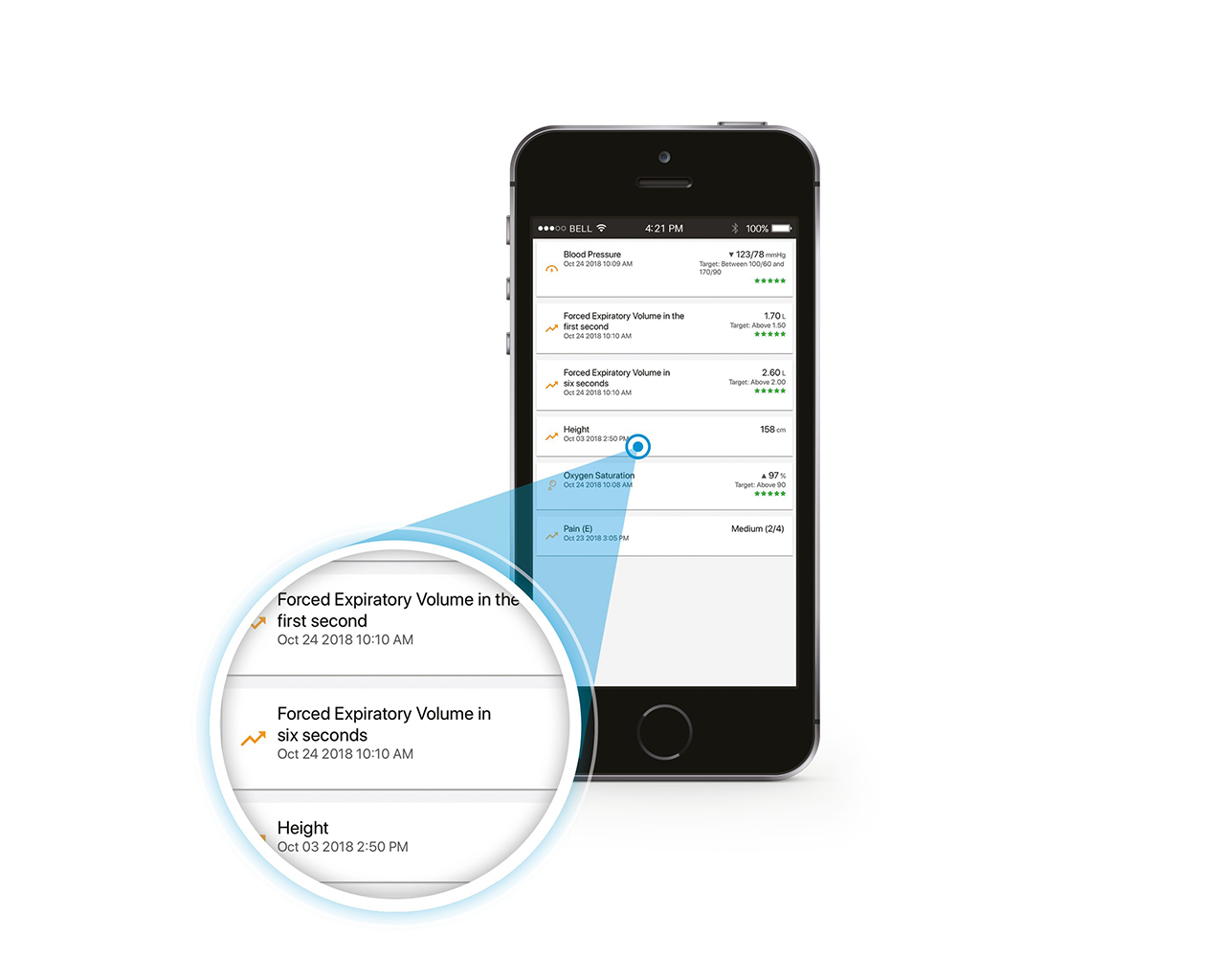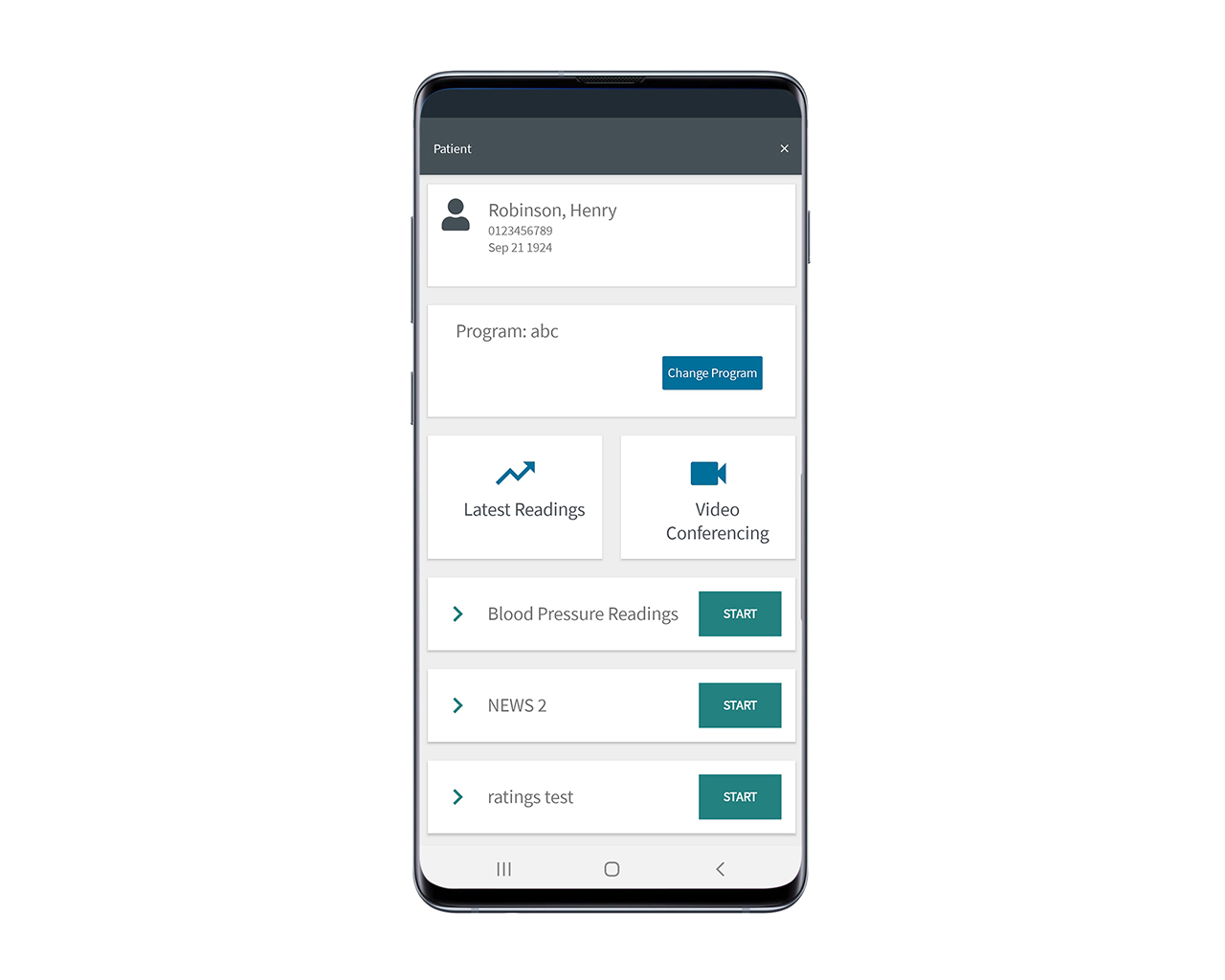Provides consolidated care
If you or someone you love is living with diabetes, you’re probably no stranger to having to set and attend regular appointments with your healthcare provider.
With Connected Health, you no longer need to queue in hospitals and clinics to get the care you need, since you can actively manage your health from the comfort of your own home.
With Tunstall’s ICP myMobile app, you can complete health interviews, view your monitor plan, review your vital signs and activity trends, and send messages or have a video conference with a clinician. This app ensures that when a client has issues with their vital signs readings or health review results, the care team will be informed immediately.

Improves diabetes treatment
Being able to monitor your blood sugar and vital signs is crucial to managing your diabetes. Our Connected Health solutions make doing these things easy, efficient, and accurate.
As your vitals are monitored in real-time, your doctors can remotely monitor your condition and advise you if it’s time to visit your GP. With advanced monitoring and timely medication, you’ll be able to manage your diabetes in the smartest way.
Tunstall offers ICP myKiosk, which is an app for clinicians and carers to help provide connected health remote chronic disease management. Available in Android and iOS, myKiosk is fully supported by Tunstall’s flagship Integrated Care Platform (ICP) which allows clinicians or caregivers access to the clients’ health interviews and monitoring plan.

Empowers patients
Through our Connected Health solutions, you can stay on top of your condition and treatment. For example, through our advanced monitoring, our system may help you to identify the things that trigger your blood sugar levels to spike or drop.
Tunstall’s range of vital signs devices can help empower people living with diabetes to take control of their own care with the reassurance that if any readings go beyond set limits, a clinical team is standing by to help.
The iHealth Blood Glucose Monitor can measure your glucose levels by checking the amount of electrical current generated when the glucose in your system reacts with the reagent of the test strip. These readings will then be automatically transmitted via Bluetooth to the myMobile app.

Improves time and cost management
Because Connected Health helps lessen your physical trips to the doctor, you’ll have more time and money to spend on your hobbies, bond with your family and other things that make you happy.
While this solution is not available in all Tunstall regions, we’d still love to speak to you and learn about your health and care needs and how technology could make a difference. Contact your local Tunstall team for more information and a chat.

There are some common myths and misconceptions about diabetes
There are several reasons why there is a lot of misinformation surrounding Diabetes. It is mainly because Diabetes is a complex condition and a lot of the information about it can often be conflicting and confusing. This can make it difficult for people to know what to believe and who to trust. As a result, many people end up believing false information about Diabetes, which can further complicate their understanding of the condition. False information about Diabetes can oftentimes be harmful and can lead to an unfair stigma around the condition.
Let’s take a look at some of the most common myths associated with Diabetes…
Myth 1: All types of Diabetes are the same.
The Facts:
There are three main types of Diabetes; each is a serious and complex condition:
Type 1 Diabetes is an autoimmune condition with no known cause. The immune system destroys the cells in the pancreas which produce insulin. As a result, ongoing blood glucose monitoring and regular insulin injections, or an insulin pump, are required.
Type 2 Diabetes is a progressive condition, where the body becomes resistant to the effects of insulin, or gradually reduces insulin production. The risk of developing Type 2 Diabetes can be affected by family history, ethnicity and lifestyle.
Gestational Diabetes occurs in pregnant women, as blood glucose levels rise above normal levels. It generally goes away once the baby is born, although it can increase the risk of developing Type 2 Diabetes later in life.
Myth 2: Diabetes is preventable.
The Facts:
While research is progressing each year, the causes of Diabetes are still largely unknown. Two of the biggest risk factors known today are genetics and family history.
There is currently no way to prevent Type 1 Diabetes, and it is not currently linked to any lifestyle risk factors.
Evidence does show that certain steps can help reduce the risk of developing gestational and Type 2 Diabetes, including improved physical exercise and diet.
Myth 3: Only people who are overweight will develop Diabetes.
The Facts:
While obesity is a risk factor for Type 2 Diabetes and gestational Diabetes, there is no direct causality. People at a healthy weight can also develop Diabetes because there are other risk factors involved including family history, age, ethnicity, and high blood pressure.
Type 1 Diabetes is not preventable, and it is not associated with weight, diet, or exercise.
Myth 4: People with Diabetes can't eat sugar.
The Facts:
While Diabetes does affect blood glucose levels, when eaten as part of a healthy diet, alongside exercise, people with Diabetes can enjoy sweets and desserts in moderation. People with Diabetes should consult a healthcare provider for expertise in developing a healthy nutritional plan, and advice on how to maintain a healthy lifestyle whilst living with Diabetes.
Myth 5: Blindness and amputation are inevitable for diabetics.
The Facts:
It's true that Diabetes can lead to blood vessel damage in the long run, which in turn leads to complications like blindness and amputation. However, with early diagnosis and proper treatment, people with Diabetes can totally avoid these complications.
There are a few things that diabetics can do to help prevent blindness, amputation, and other complications. First, it is important to have regular checkups with a healthcare provider to monitor blood glucose levels and catch any potential problems early. Second, diabetics should make sure to keep their blood pressure under control by having a healthy diet rich in fruits and vegetables and by staying active. Lastly, it is important for diabetics to keep physical or mental stressors at bay because stress can cause blood glucose levels to rise.
Myth 6: People with Diabetes can't be active.
The Facts:
This is true to some extent as people with Diabetes might need to take certain precautions depending on their health status. But staying active is one of the best ways for diabetics to improve their glucose control. Exercise, including both aerobic and resistance training, is an important part of managing Diabetes and has many health benefits including controlling blood sugar levels, reducing the risk of complications, and even improving insulin sensitivity.
Related reading: What stops older people from exercising and how you can help
Myth 7: Only adults get Diabetes.
The Facts:
While it is true that adults are more likely to develop Diabetes, the condition can also occur in children. In fact, Type 1 Diabetes is the most common form of Diabetes in children, and there are around 11,000 Australian children and teenagers living with Diabetes.



